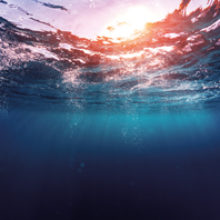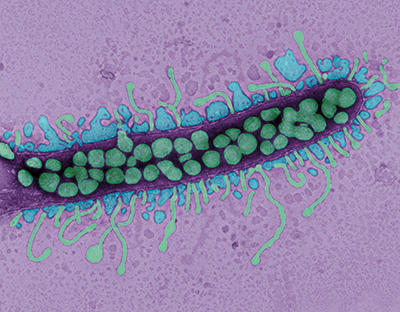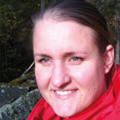Viruses – the invisible majority of the oceans
Issue: Oceans
05 February 2019 article

Virus research has shown the great importance of viruses in marine ecosystems. While the astronomical number and diversity of ocean viruses provides endless possibilities for new discoveries, man-induced climate change could dramatically affect the delicate balance of virus–host interactions that play a central role in global biogeochemical cycles.
It is astonishing to think of the effect oceans have on our lives. Life itself and the quality of it depend on the health of the world’s oceans. Estimates indicate that over half of the planet’s oxygen is produced by the phytoplankton living in ocean surface waters. The world’s seas also serve as a major carbon dioxide (CO2) sink by adsorbing the greenhouse gas from the atmosphere. Further, phytoplankton play an important role, using vast amounts of CO2 for growing. CO2 is later deposited to the bottom of the ocean by sinking with the decaying phytoplankton. Oceans hold 97% of the world’s water and cover nearly three-quarters of the surface. Thus, it is no wonder that they absorb nearly half of the heat arriving from the sun. Heat is distributed all over the world via sea currents, which contribute to the temperate climate in northwest Europe, for example. Although it is evident that oceans are crucial for life in many ways, it has only been in the past three decades that we have recognised the key players influencing global-scale biogeochemical cycles and ocean productivity. They are the invisible, but highly influential, viruses.
The astronomical abundance and diversity of marine viruses
All cells are likely to be susceptible to infection by at least one virus. Although many viruses cause disease in plants or animals, the majority of viruses in the biosphere infect prokaryotes. It was three decades ago when Norwegian researchers excited the scientific community with the realisation that viruses are not only highly abundant, but also a major cause of mortality of the most abundant organisms in the sea; bacteria and archaea. This finding initiated research into marine viruses that quickly developed into a completely independent research field.
Viruses inhabit the world’s oceans in great numbers. One spoonful of seawater can hold up to a billion virus particles – a number equal to one-seventh of the global human population! And the carbon carried in viruses is approximately equal to 75 million blue whales. Traditional and advanced research techniques have revealed the enormous genetic and morphological diversity of marine viruses. A typical isolated marine phage (a virus-infecting bacteria) has a head and tail structure, which is true for approximately 97% of all isolated and characterised phage. However, data suggests that the most abundant morphotype of marine viruses is actually a tailless capsid. The reason that this type is not frequently isolated remains to be understood. Several marine metagenomes have revealed that oceans host a large number of unknown viral populations. Thus, there is a great need for detailed studies on isolated viruses and their hosts to enable the identification of this so-called ‘dark matter’.
Besides the genetic complexity of viruses, there are different life cycles that they can display, and it is probable that there is more variety in the life cycles that is not yet discovered. Let’s look at a phage and its bacterial host as an example. The most thoroughly studied and understood examples are the lytic and lysogenic life cycles. In a lytic cycle, the phage enters the cell, the host’s replication machinery is taken over by the invading phage genome and new phage particles are assembled. In the final part of the infectious cycle, the host cell is lysed and new mature phages are released to the surrounding environment. In a lysogenic life cycle, a temperate phage enters the cell and its genome is integrated into the continuity of the host chromosome. In some cases, the phage genome can remain in the cell as an extrachromosomal element. Formed prophages can replicate with the host genome until a cellular or environmental stimulus induces the start of a productive lytic cycle. In many cases, prophages provide the host bacterium with beneficial genes. This so-called lysogenic conversion can enable, maybe most famously, the production of toxin genes that are important in the virulence of pathogenic bacteria. Prophages can potentially also enhance host survival during unfavourable conditions by suppressing metabolic activities, which is especially relevant in the fluctuating marine environment. The lysis–lysogeny decision has been extensively studied in a few example phage–host systems, but studies in marine systems are rare. Understanding how the environment modifies life cycle decisions is crucial for predicting how it might influence future virus–host interactions. Undoubtedly, the factors involved in life cycle decisions are of great importance to marine nutrient cycling, controlling the mortality caused by viruses.
Marine viruses are key players in food webs and biogeochemical cycling in the world’s oceans
In the ocean, one of the major causes of mortality of micro-organisms is grazing by protozoa, which are then themselves consumed by plankton, fish and other larger organisms. An equally important cause of mortality is viral infection. Usually, the end of the infection cycle results in the death of the host. In addition to bacteria, the majority of which are photosynthetic cyanobacteria, viruses infect microzooplankton and other phytoplankton, a large proportion constituting eukaryotic algae. Hence, large double-stranded DNA viruses that infect algae are of special interest as, similarly to phages, they contribute greatly to the global environment.
Viral lysis of microbial cells releases organic carbon and nutrients into the pool of dissolved organic matter (DOM). DOM is then re-mineralised by microbes within the microbial loop that can be considered as a recycling system of the ocean. This viral shunt keeps the carbon and nutrients available in the surface waters. Together, phages and other viruses significantly control the marine microbial populations; their role in the nutrient and carbon cycling, and in controlling the speed of these cycles is therefore central. Many studies have without a doubt shown that viruses shape aquatic microbial population size as well as determine ecosystem dynamics.

Marine virus–host interactions are vulnerable
How global climate change affects marine host–virus interactions is largely unknown. There are several variables in the changing environment, such as temperature and salinity, which have a direct effect on the virus–host interactions that further impact the biosphere. It is speculated that marine viruses could have a broad spectrum of direct and indirect effects on climate change. In addition, the magnitude of these effects is not well assessed, which in turn results in the exclusion of viruses from most climate change models. Therefore, there is a growing need to understand the human-made effects to the level of detailed virus–host interactions. However, it is clear that climate change, acidification and pollution are going to change the dynamics of these small but important players. The importance of the viral populations in marine environments should not be neglected, and they should be considered in all models.
Oceans, as well as other water sources, undoubtedly remain the eternal garden for new discoveries, especially for virologists. The possibilities to expand our understanding not only about the biology of viruses, but also the complex web of interactions thriving in these important ecosystems, are perhaps endless.
Further reading
Breitbart M, Bonnain C, Malki K, Sawaya NA. Phage puppet masters of the marine microbial realm. Nat Microbiol 2018;3:754.
Danovaro R, Corinaldesi C, Dell'Anno A, Fuhrman J A, Middelburg JJ et al. Marine viruses and global climate change. FEMS Microbiol Rev 2011;36:993–1034.
Suttle CA. Viruses in the sea. Nature 2005;437:356–361.

Elina Laanto
Department of Biological and Environmental Science and Nanoscience Center, University of Jyvaskyla, PO Box 35, FI-40014, Finland
[email protected]
Twitter: @elaanto
Elina Laanto is a postdoctoral researcher working with phage-host interactions in aquatic systems.
On a typical day/week what do you do?
My day consists of a mix of office and lab work. Depending on the project, I do experiments in the lab or write papers. Much of the work is done together with the other members of the research group and collaborators, so there is a lot of communication during the day. I also supervise students in the lab and teach courses occasionally.
What do you find most enjoyable about your work?
I am fascinated by the complexity of bacteria and their viruses, and how little we understand about the microbial world. I feel lucky that I can work with such an interesting system, use my creativity for testing hypotheses, and answer questions and consider new ones.
Image 1: mihtiander/Thinkstock.
Image 2: Coloured transmission electron micrograph (TEM) of pelagipodovirus HTVC011P pelagiphages (darker green) infecting a ‘Candidatus Phytoplasma’ sp. bacterium (rod-shaped). This phage, discovered in 2013, mainly infects SAR11 marine bacteria, which were previously thought to be immune to viral infection. Magnification: x96,300. Thomas Deerinck, NCMIR/Science Photo Library.
